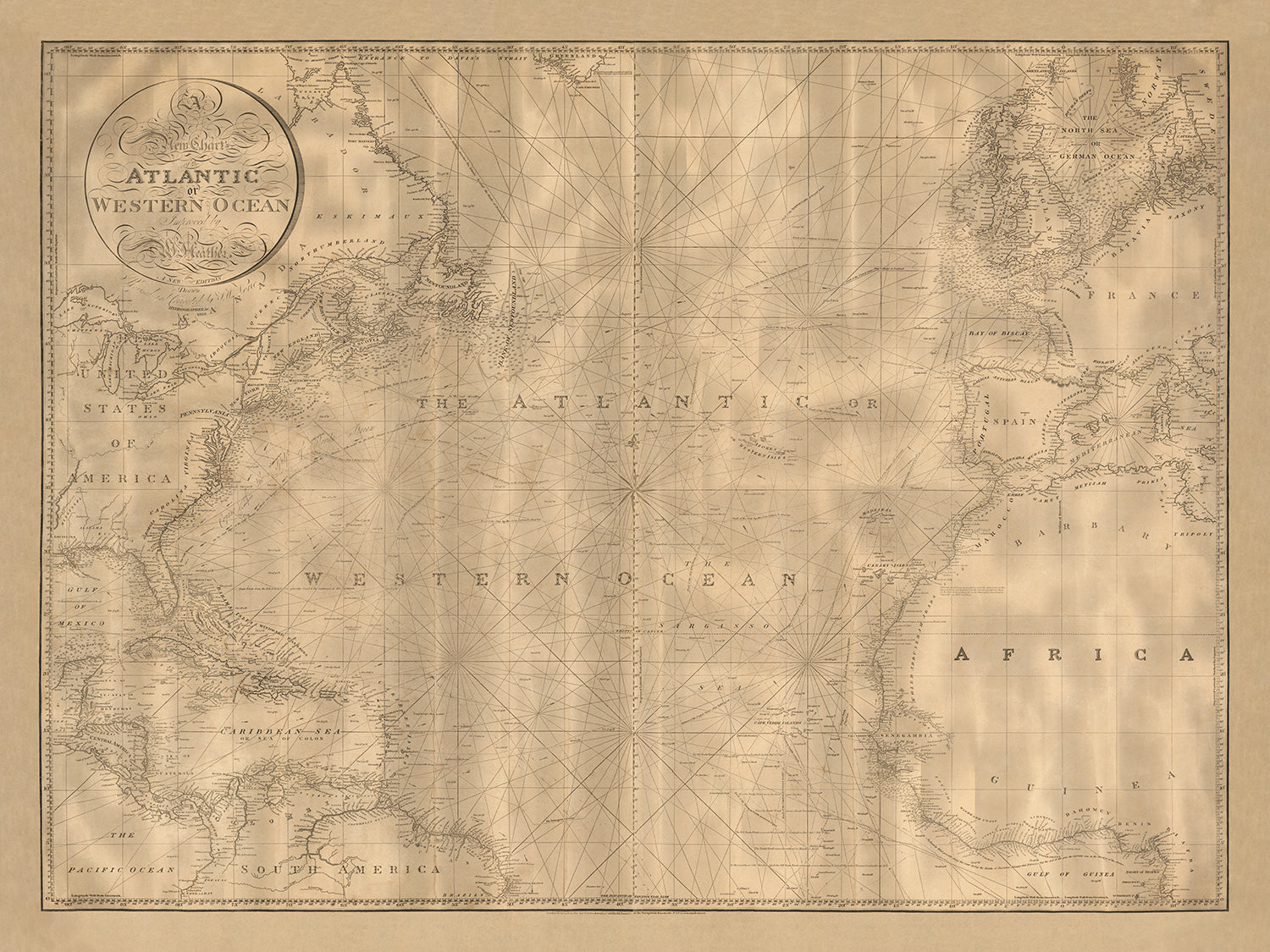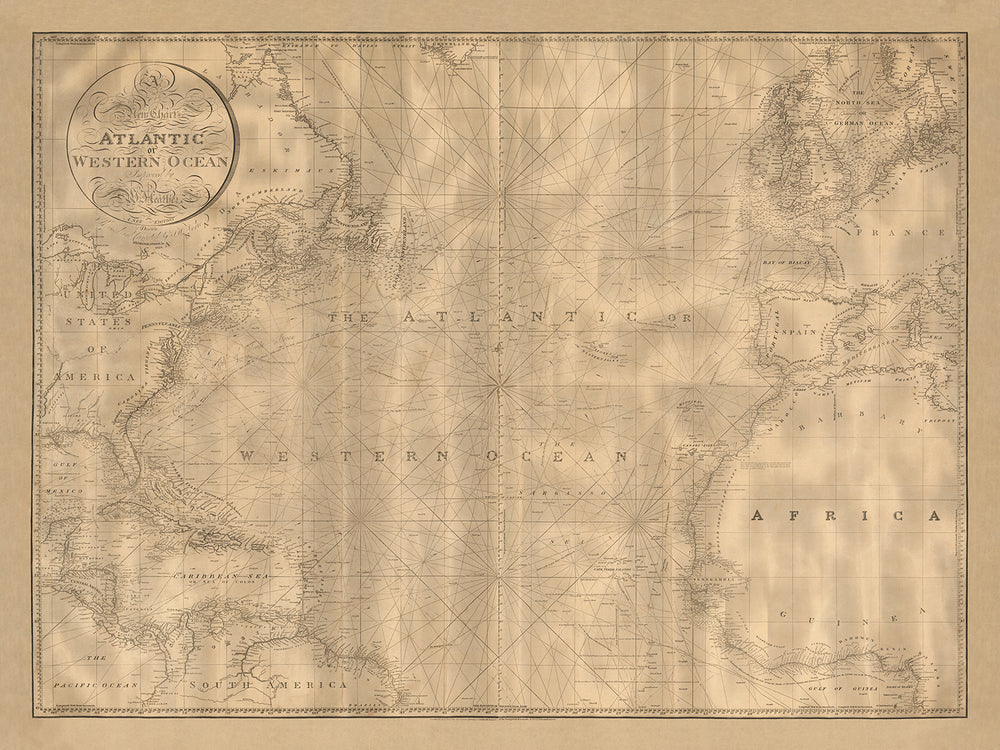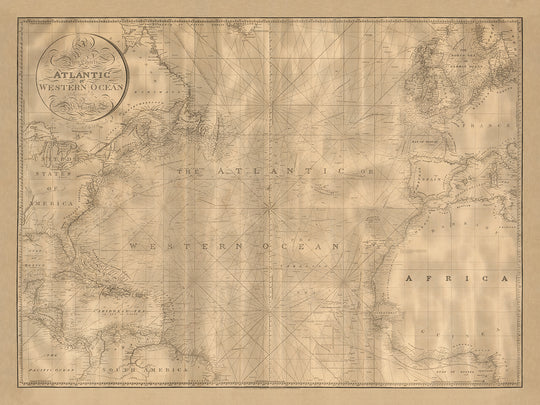- Handmade locally. No import duty or tax
- FREE worldwide delivery
- Love it or your money back (90 days)
- Questions? WhatsApp me any time
Own a piece of history
5,000+ 5 star reviews


This exquisite nautical chart, "A New Chart of the Atlantic or Western Ocean Improved by W. Heather," is a remarkable piece of maritime history, meticulously revised and corrected by the esteemed hydrographer John W. Norie in 1828. This map captures the essence of early 19th-century navigation, showcasing the intricate details of the Atlantic Ocean, including the Gulf Stream and prevailing currents between the Caribbean and Europe. It offers a fascinating glimpse into the maritime routes and the understanding of oceanography at the time, making it an invaluable artifact for historians and enthusiasts alike.
The map's primary focus is on the Atlantic Ocean, detailing the vast expanse from the United States and the Caribbean to the shores of Europe and Africa. It meticulously tracks the Gulf Stream, a critical current for navigation, and highlights the prevailing currents that were essential for transatlantic voyages. The inclusion of these oceanographic features not only underscores the map's practical use for sailors but also reflects the scientific knowledge of the period, making it a significant educational tool.
One of the most captivating aspects of this chart is the detailed depiction of voyage routes, including a notable journey from New York across the Atlantic, below the Equator, and along the coasts of South America and Africa, culminating at the Cape Verde Islands. These tracks provide a tangible connection to the historical voyages undertaken during the age of exploration and trade, offering a narrative of the challenges and triumphs faced by early mariners. The map serves as a testament to the adventurous spirit and navigational prowess of the time.
The design and style of the map are exemplary of early 19th-century cartography, with precise soundings (water depths in fathoms) and navigational aids such as compass roses and water channels. The detailed coastlines of the Americas, Europe, and Africa are rendered with remarkable accuracy, showcasing the cartographer's skill and attention to detail. The map's condition, despite showing signs of use, speaks to its authenticity and the practical role it played in maritime navigation.
William Heather, the original creator of this chart, and John W. Norie, who revised and corrected it, were both prominent figures in the field of hydrography. Their collaboration on this map highlights the evolution of nautical charting and the advancements in understanding ocean currents and navigation routes. This chart not only serves as a functional navigational tool but also as a piece of art, reflecting the rich history of maritime exploration and the enduring legacy of early cartographers.
Notable places on this map
- Towns and harbours:
- New York
- Various coastal towns and harbours along the Americas, Europe, and Africa.
- Rivers:
- Major rivers along the coastlines (not specifically labeled but inferred from the map).
- Islands:
- Cape Verde Islands
- Caribbean islands
- Structures:
- Coastal fortifications and lighthouses (if any, inferred from the map).
- Topography:
- Coastal topography of the Americas, Europe, and Africa.
- Regions:
- Gulf of Mexico
- Caribbean Sea
- Countries:
- United States of America
- Spain
- France
- Various countries in Africa
- Oceanic features:
- The Atlantic Ocean
- Western Ocean
- Currents and channels:
- Gulf Stream
- Other prevailing currents and water channels
Notable Features & Landmarks
- Geographical area shown:
- The Atlantic Ocean, including the Western Ocean.
- Historical context:
- Shows the understanding of the Gulf Stream and other prevailing currents in the early 19th century.
- Navigational aids:
- Compass roses.
- Tracks of voyages.
- Soundings (water depths in fathoms).
- Coastal features:
- Detailed coastlines of the Americas, Europe, and Africa.
- Prominent islands:
- Cape Verde Islands.
- Caribbean islands.
- Ocean currents:
- Gulf Stream.
- Voyage routes:
- Tracks from New York across the Atlantic.
- Map condition:
- Shows signs of use but remains in good condition.
- Hydrographic details:
- Detailed hydrographic information for navigation.
- Cultural and historical significance:
- Reflects maritime exploration and trade routes of the early 19th century.
Historical and design context
- Name of the map: A New Chart of the Atlantic or Western Ocean Improved by W. Heather
- Extra notes:
- Nice example of William Heather's scarce chart of the Atlantic Ocean.
- This is a "New Edition" by John W. Norie, dated 1828.
- One of the best large format charts of the Atlantic published in the first half of the 19th Century.
- Tracks the Gulf Stream and prevailing currents between the Caribbean and Europe, as known at the beginning of the 19th Century.
- Includes the tracks of a journey from New York, across the Atlantic below the Equator and South America and/or the West Coast of Africa, then to The Cape Verde Islands.
- The map shows some signs of use but is in remarkably good condition for a working sea chart.
- When the map was made: 1828
- Mapmaker or publisher:
- Created by William Heather.
- Revised and corrected by John W. Norie, a noted hydrographer.
- Topics and themes:
- Nautical chart focusing on maritime navigation.
- Shows the Gulf Stream and prevailing currents.
- Tracks of historical voyages.
- Design or style:
- Large format sea chart.
- Detailed with soundings (water depths in fathoms) and navigational aids such as compass roses and currents.
- Historical significance:
- Provides insights into early 19th-century maritime navigation and oceanography.
- Reflects the understanding of ocean currents and navigation routes of the time.
Please double check the images to make sure that a specific town or place is shown on this map. You can also get in touch and ask us to check the map for you.
This map looks great at every size, but I always recommend going for a larger size if you have space. That way you can easily make out all of the details.
This map looks amazing at sizes all the way up to 50in (125cm). If you are looking for a larger map, please get in touch.
The model in the listing images is holding the 18x24in (45x60cm) version of this map.
The fifth listing image shows an example of my map personalisation service.
If you’re looking for something slightly different, check out my collection of the best old maps to see if something else catches your eye.
Please contact me to check if a certain location, landmark or feature is shown on this map.
This would make a wonderful birthday, Christmas, Father's Day, work leaving, anniversary or housewarming gift for someone from the areas covered by this map.
This map is available as a giclée print on acid free archival matte paper, or you can buy it framed. The frame is a nice, simple black frame that suits most aesthetics. Please get in touch if you'd like a different frame colour or material. My frames are glazed with super-clear museum-grade acrylic (perspex/acrylite), which is significantly less reflective than glass, safer, and will always arrive in perfect condition.
This map is also available as a float framed canvas, sometimes known as a shadow gap framed canvas or canvas floater. The map is printed on artist's cotton canvas and then stretched over a handmade box frame. We then "float" the canvas inside a wooden frame, which is available in a range of colours (black, dark brown, oak, antique gold and white). This is a wonderful way to present a map without glazing in front. See some examples of float framed canvas maps and explore the differences between my different finishes.
For something truly unique, this map is also available in "Unique 3D", our trademarked process that dramatically transforms the map so that it has a wonderful sense of depth. We combine the original map with detailed topography and elevation data, so that mountains and the terrain really "pop". For more info and examples of 3D maps, check my Unique 3D page.
For most orders, delivery time is about 3 working days. Personalised and customised products take longer, as I have to do the personalisation and send it to you for approval, which usually takes 1 or 2 days.
Please note that very large framed orders usually take longer to make and deliver.
If you need your order to arrive by a certain date, please contact me before you order so that we can find the best way of making sure you get your order in time.
I print and frame maps and artwork in 23 countries around the world. This means your order will be made locally, which cuts down on delivery time and ensures that it won't be damaged during delivery. You'll never pay customs or import duty, and we'll put less CO2 into the air.
All of my maps and art prints are well packaged and sent in a rugged tube if unframed, or surrounded by foam if framed.
I try to send out all orders within 1 or 2 days of receiving your order, though some products (like face masks, mugs and tote bags) can take longer to make.
If you select Express Delivery at checkout your order we will prioritise your order and send it out by 1-day courier (Fedex, DHL, UPS, Parcelforce).
Next Day delivery is also available in some countries (US, UK, Singapore, UAE) but please try to order early in the day so that we can get it sent out on time.
My standard frame is a gallery style black ash hardwood frame. It is simple and quite modern looking. My standard frame is around 20mm (0.8in) wide.
I use super-clear acrylic (perspex/acrylite) for the frame glass. It's lighter and safer than glass - and it looks better, as the reflectivity is lower.
Six standard frame colours are available for free (black, dark brown, dark grey, oak, white and antique gold). Custom framing and mounting/matting is available if you're looking for something else.
Most maps, art and illustrations are also available as a framed canvas. We use matte (not shiny) cotton canvas, stretch it over a sustainably sourced box wood frame, and then 'float' the piece within a wood frame. The end result is quite beautiful, and there's no glazing to get in the way.
All frames are provided "ready to hang", with either a string or brackets on the back. Very large frames will have heavy duty hanging plates and/or a mounting baton. If you have any questions, please get in touch.
See some examples of my framed maps and framed canvas maps.
Alternatively, I can also supply old maps and artwork on canvas, foam board, cotton rag and other materials.
If you want to frame your map or artwork yourself, please read my size guide first.
My maps are extremely high quality reproductions of original maps.
I source original, rare maps from libraries, auction houses and private collections around the world, restore them at my London workshop, and then use specialist giclée inks and printers to create beautiful maps that look even better than the original.
My maps are printed on acid-free archival matte (not glossy) paper that feels very high quality and almost like card. In technical terms the paper weight/thickness is 10mil/200gsm. It's perfect for framing.
I print with Epson ultrachrome giclée UV fade resistant pigment inks - some of the best inks you can find.
I can also make maps on canvas, cotton rag and other exotic materials.
Learn more about The Unique Maps Co.
Map personalisation
If you're looking for the perfect anniversary or housewarming gift, I can personalise your map to make it truly unique. For example, I can add a short message, or highlight an important location, or add your family's coat of arms.
The options are almost infinite. Please see my map personalisation page for some wonderful examples of what's possible.
To order a personalised map, select "personalise your map" before adding it to your basket.
Get in touch if you're looking for more complex customisations and personalisations.
Map ageing
I have been asked hundreds of times over the years by customers if they could buy a map that looks even older.
Well, now you can, by selecting Aged before you add a map to your basket.
All the product photos you see on this page show the map in its Original form. This is what the map looks like today.
If you select Aged, I will age your map by hand, using a special and unique process developed through years of studying old maps, talking to researchers to understand the chemistry of aging paper, and of course... lots of practice!
If you're unsure, stick to the Original colour of the map. If you want something a bit darker and older looking, go for Aged.
If you are not happy with your order for any reason, contact me and I'll get it fixed ASAP, free of charge. Please see my returns and refund policy for more information.
I am very confident you will like your restored map or art print. I have been doing this since 1984. I'm a 5-star Etsy seller. I have sold tens of thousands of maps and art prints and have over 5,000 real 5-star reviews. My work has been featured in interior design magazines, on the BBC, and on the walls of dozens of 5-star hotels.
I use a unique process to restore maps and artwork that is massively time consuming and labour intensive. Hunting down the original maps and illustrations can take months. I use state of the art and eye-wateringly expensive technology to scan and restore them. As a result, I guarantee my maps and art prints are a cut above the rest. I stand by my products and will always make sure you're 100% happy with what you receive.
Almost all of my maps and art prints look amazing at large sizes (200cm, 6.5ft+) and I can frame and deliver them to you as well, via special oversized courier. Contact me to discuss your specific needs.
Or try searching for something!















































